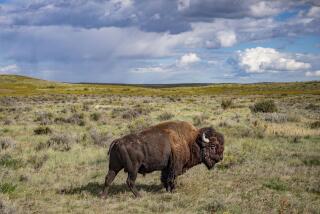BOOK REVIEW / NONFICTION : Walking a Pathway of American History : A WAY THROUGH THE WILDERNESS: The Natchez Trace and the Civilization of the Southern Frontier <i> by William C. Davis</i> , HarperCollins, $30, 382 pages
- Share via
The Natchez Trace is a path through the primeval woodlands of the South that played a crucial but mostly unsung role in the settlement of the American frontier and “the most dramatic exodus in history to date,” as William C. Davis puts it in “A Way Through the Wilderness.”
“Instinct and logic of both animals and men had located it where it best served the interest of travel in the rough wilderness,” Davis writes. “By this trail virtually everything came originally to the Old Southwest.”
Reaching from Nashville on the Cumberland River to Natchez on the Mississippi, the Natchez Trace followed the paths and byways that were first used by Native Americans. For a period of 50 years or so, the same route was used by settlers and soldiers, peddlers and pedants, and miscellaneous entrepreneurs who trafficked in everything from indigo and tobacco to slaves.
“The Old Southwest, like the stands along the Trace, served in a way as a stopover,” Davis explains, “a way station on the westward road of empire.”
Davis, author of some 35 books on the Civil War and the history of the South, discloses that his latest book started out as a biography of the frontiersman that Walt Disney made so famous, Davy Crockett. But when Davis heard that a couple of other Crockett biographies were already in the works, he decided to take a more expansive view of early 19th-Century American history by chronicling the Natchez Trace itself.
Crockett is still in the book--and we discover that he set off into the wilderness to evade his creditors after his distillery was destroyed by a flood--but so are a parade of unlikely characters who are mostly overlooked in the study of American history: “Merchants, bankers, planters, soldiers, the larger-than-life ‘Kaintucks,’ and the low-life gamblers and whores,” as Davis writes.
Davis is not an academic historian, but there’s no lack of scholarship here. Indeed, the book is chunked with rich historical data that starts with distant geological origins of the land itself--”Ages before there were names or men to assign them”--and rolls all the way up to the signing of the Treaty of Doak’s Stand in 1820, when Andrew Jackson presided over the final subjugation of the Chocktaw Nation and the closing of the frontier along the Natchez Trace.
“Those nations existed no more,” writes Davis of the Chocktaw and the Chickasaw, “swallowed by the irresistible hunger and opportunism of white America on the march.”
Still, Davis adopts a soaring narrative voice that is seldom heard in the halls of academe, and he delights in the well-documented anecdote that often reads like a wild yarn told by a grizzled boatman around a campfire. And, almost incidentally, Davis succeeds in debunking much of what we think we know about the frontier.
Native Americans, for example, often posed less of a threat to settlers than such commonplace dangers as poison ivy (or “poison vine,” as they called it) or high water and bad weather. And even these perils were not the most fearful.
“Surprisingly enough, one of the most common dangers to the travelers in either direction came not from Indians or bandits or even the weather,” Davis writes, “but from the spookiness of their animals.”
For example, he introduces us to one plucky young mother named Martha Martin whose leg was shattered in a buggy accident caused by a runaway horse along the Natchez Trace in 1814--and only a field amputation at a nearby plantation, performed without anesthesia, saved her life.
The tale of Martha Martin is only one small scene in the vast tableau that Davis presents here, but it’s typical of what Davis does best in “A Way Through the Wilderness.” He manages to describe a phenomenon so diffuse that it defies ordinary storytelling--but he does it by allowing the day-to-day lives of real men and women to stand for the vast sweep of American history.
“My suffering was only known to God and myself,” Martha later recalled--but she threw away her crutches when the family set out again on the Natchez Trace: “For the rest of her ninety-four years,” Davis tells us, “she hopped on her right foot instead, living testimony to the spirit and resilience of a frontier woman.”
More to Read
Sign up for our Book Club newsletter
Get the latest news, events and more from the Los Angeles Times Book Club, and help us get L.A. reading and talking.
You may occasionally receive promotional content from the Los Angeles Times.








